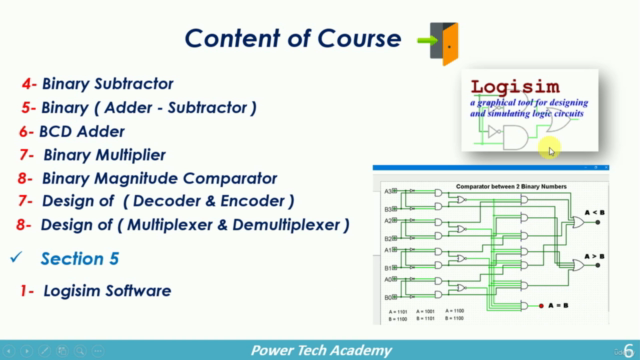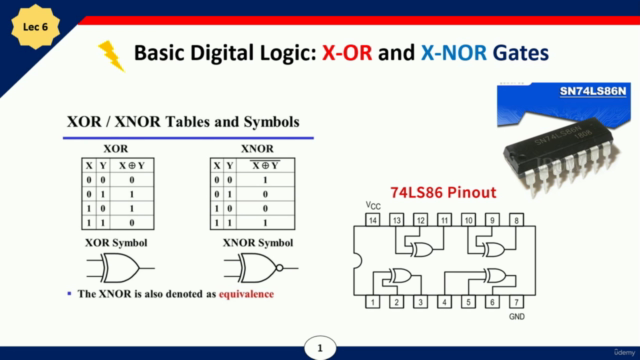Ultimate 2022 Digital Circuits and Logic Design course
A complete guide for learning the Digital circuits and Logic design using Logisim & Multisim & practical applications
4.60 (20 reviews)

187
students
7 hours
content
Jul 2022
last update
$19.99
regular price
Why take this course?
-
Fundamentals of Digital Systems:
- Basic concepts and principles of digital systems, including number systems (binary, octal, hexadecimal), digital signal characteristics, and the fundamentals of logic design.
- Introduction to Boolean algebra, digital logic gates (AND, OR, NOT, NAND, NOR, XOR, XNOR), and their symbolic representation.
- Understanding of Combinational Logic vs Sequential Logic and the difference between them.
-
Combinational Logic Circuits:
- Design and implementation of basic combinational circuits such as half adders, full adders, binary adder/subtractor, BCD adder, binary multiplier, binary magnitude comparator, decoders, encoders, multiplexers, and demultiplexers.
- Utilization of Karnaugh Maps (K-maps) for simplifying Boolean expressions, understanding don't care conditions, and finding prime implicants to derive the minimum SOP (Sum of Products) or POS (Product of Sums).
- Study of various types of K-maps for 2, 3, 4, and 5 variables, including canonical forms and essential and prime implications.
-
Digital Logic Design Tools:
- Introduction to Logisim software, a free digital logic circuit simulator used to model combinational and sequential circuits.
- Learning to create, simulate, and analyze digital circuits using Logisim.
-
Logic Waves and Devices of Measuring for Digital Systems:
- Understanding the parameters of logic waves: period, frequency, and duty cycle.
- Familiarity with basic digital devices such as LEDs, 7-segment displays, dot matrix displays, resistors, and integrated circuits (ICs).
- Knowledge of measuring devices used in digital systems: oscilloscopes for signal measurement, logic analyzers for event timing and waveform analysis, and function generators for creating test signals.
-
Digital Systems Laboratory:
- Practical implementation of some logic circuits using a breadboard to gain hands-on experience in building digital systems.
-
Sequential Logic Circuits:
- Types of sequential logic circuits and their applications.
- Detailed study of latches (SR latch, D latch, and JK flip-flop).
- Study of flip-flops (D, JK, and T types).
- Concepts and design of a Finite State Machine (FSM), which is a fundamental model of a sequential logic circuit.
- Other sequential logic circuits, including counters, registers, and memory elements.
-
Multisim Software:
- Introduction to Multisim software, an electronic prototyping platform that allows for the simulation of analog and mixed-signal circuits.
- Learning to model digital and analog circuits in Multisim and analyze their performance.
-
Advanced Topics in Digital Systems:
- Advanced sequential circuits, error detection and correction techniques, cryptography, microprocessor systems, FPGA (Field Programmable Gate Array), and other modern digital system technologies.
-
Capstone Project/Industry Application:
- A final project or practical application that integrates the concepts of combinational and sequential logic, using software tools like Logisim or Multisim to design a complex digital system or to solve a real-world problem.
This curriculum provides a comprehensive overview of digital systems, from the basics of combinational logic to the more advanced topics in sequential logic and applications. It prepares students for further studies in digital electronics, computer engineering, or related fields.
Course Gallery




Loading charts...
Related Topics
4228936
udemy ID
07/08/2021
course created date
17/08/2021
course indexed date
Bot
course submited by